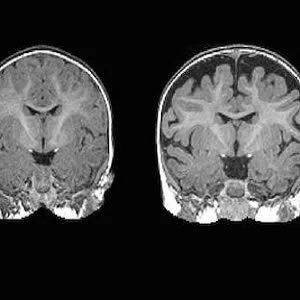A new study in the journal Biological Psychiatry says a substantially greater amount of extra-axial cerebrospinal fluid (CSF) in high-risk infants can predict whether they will develop autism. The more CSF at six months – as measured through MRIs – the more severe the autism symptoms were at two years of age, according to UNC School of Medicine's Joseph Piven, MD, co-senior author of the study.
See Also: MRIs Used in New Study to Predict Which Infants Will Develop Autism
"The CSF is easy to see on standard MRIs and points to a potential biomarker of autism before symptoms appear years later," says Dr. Piven, the Thomas E. Castelloe Distinguished Professor of Psychiatry, and director of the Carolina Institute for Developmental Disabilities (CIDD). "We also think this finding provides a potential therapeutic target for a subset of people with autism."
Produced by the brain, CSF was once cast as a neural shock absorber, keeping the brain from bumping up against the skull. More recent findings have shown that CSF can influence neuronal migration and other mechanisms associated with brain development, as well as removing dangerous molecules.
"CSF is like the filtration system in the brain," explains Mark Shen, PhD, CIDD postdoctoral fellow and first author of the study. "As CSF circulates through the brain, it washes away waste particles that would otherwise build up. We believe that extra-axial CSF is an early sign that CSF is not filtering and draining when it should. The result is that there could be a buildup of neuro-inflammation that isn't being washed way."
In 2013, Shen co-led a study of CSF in infants at UC Davis, where he worked with David Amaral, PhD, co-senior author of the current Biological Psychiatry study. Using MRIs, they found substantially greater volumes of CSF in babies that went on to develop autism. But they cautioned the study was small – it included 55 babies, 10 of whom developed autism later – and so it needed to be replicated in a larger study of infants.
When he came to UNC, Shen teamed up with Piven and colleagues of the Infant Brain Imaging Study (IBIS), a network of autism clinical assessment sites at UNC, the University of Pennsylvania, Washington University in St. Louis, and the University of Washington.
To test whether CSF might indicate increased risk of developing autism, the researchers examined MRIs from 343 infants at six, 12 and 24 months. In this group, 221 babies were at high risk of developing autism due to having an older sibling with the condition. The other 122 subjects had no family history.
Forty-seven of these infants were diagnosed with autism at 24 months, and their infant brain MRIs were compared to MRIs of other infants who were not diagnosed with autism at 24 months of age. The six-month olds who went on to develop autism had 18 percent more CSF than six-month olds who did not develop autism. The amount of CSF remained elevated at 12 and 24 months. Infants who developed the most severe autism symptoms had an even greater amount of CSF – 24 percent greater at six months. These measurements predicted autism in the high-risk group with nearly 70 percent accuracy.
"Normally, autism is diagnosed when the child is two or three years old and beginning to show behavioural symptoms; there are currently no early biological markers," notes David G. Amaral, director of research at the UC Davis MIND Institute and a co-senior author of the study. "That there's an alteration in the distribution of cerebrospinal fluid that we can see on MRIs as early as six months, is a major finding."
Source: University of North Carolina Health Care; UC Regents
Image Credit: Carolina Institute for Developmental Disabilities (UNC-Chapel Hill)
References:
Mark D. Shen, Sun Hyung Kim, Robert C. McKinstry, Hongbin Gu, Heather C.
Hazlett, Christine W. Nordahl, Robert E. Emerson, Dennis Shaw, Jed T.
Elison, Meghan R. Swanson, Vladimir S. Fonov, Guido Gerig, Stephen R.
Dager, Kelly N. Botteron, Sarah Paterson, Robert T. Schultz, Alan C.
Evans, Annette M. Estes, Lonnie Zwaigenbaum, Martin A. Styner, David G.
Amaral, Joseph Piven. (2017) Increased Extra-axial Cerebrospinal Fluid in High-Risk Infants who Later Develop Autism. Biological Psychiatry; DOI: 10.1016/j.biopsych.2017.02.1095
Latest Articles
A new study in the journal Biological Psychiatry says a substantially greater amount of extra-axial cerebrospinal fluid (CSF) in high-risk infants can predict whether they will develop autism.






